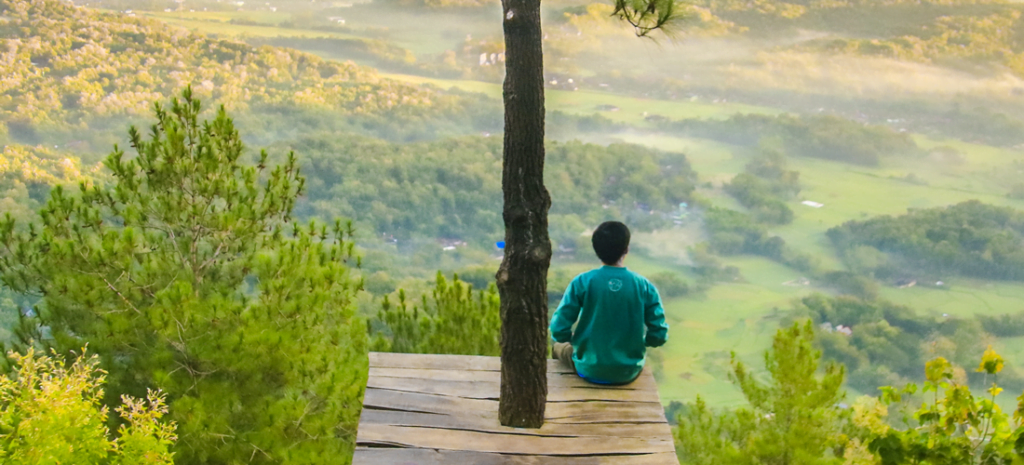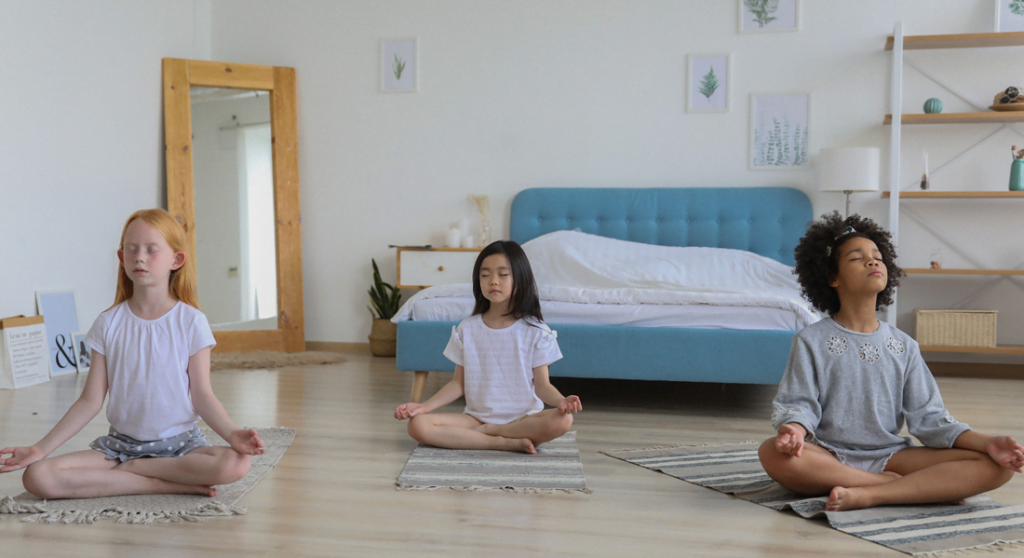Embracing solitude can have transformative effects on our wellbeing, especially when it’s combined with nurturing our bond with nature. This harmonious blend, known as Environmental Self-Care through Solitude, allows us to recharge our mental and emotional batteries while being conscious of our environmental footprint. Let’s explore practical ways to incorporate solitude into your environmental self-care routines. We will look into activities that boost personal wellness and foster a deeper respect for our planet, all while enjoying the enriching tranquility of solitude.
Environmental self-care refers to practices that are directed towards preserving the environment while also promoting personal wellness. These actions are not just environmentally-friendly, but also have healing effects on our minds and bodies. Activities such as nature walks, gardening, or simply enjoying the serenity of a park are examples of environmental self-care that can help reduce stress, improve mood, and boost overall health.
Solitude plays a role of paramount importance in fostering environmental consciousness. When we take time for solitude, we cultivate a deeper connection with ourselves and with the natural world around us. This connection can dramatically increase our appreciation and respect for the environment, prompting us to make more sustainable choices in our daily lives. Alone in nature, we can reflect on our place in the world and our responsibility to protect it. In essence, the bond between solitude and environmental consciousness is an intimate one, reinforcing our commitment to both personal well-being and planetary health.
Tips for Environmental Self-Care through Solitude
Nature Immersion:
Mindful Nature Walks:
Take deliberate walks in natural settings, paying attention to the details of the environment. Disconnect from technology to fully engage with nature.
Mindful nature walks are a potent means of practicing environmental self-care through solitude. This activity facilitates a deeper connection with the natural world, allowing us to observe and appreciate the beauty and intricacies of our environment.
It sparks our curiosity about the natural systems that sustain life on earth, fostering a sense of awe and respect. As we become more mindful of the sights, sounds, and sensations of nature, we also become more aware of our own physical and emotional responses to the environment.
This mindfulness can lead to an increased sense of calm and well-being, thus contributing to our overall health and happiness. Furthermore, as we deepen our connection with nature, we are likely to feel a stronger desire to protect and preserve it, thereby integrating environmental consciousness into our self-care routine.
In essence, mindful nature walks integrate the power of solitude, the healing benefits of nature, and the imperative for environmental stewardship, making it a holistic approach to environmental self-care.
Solo Outdoor Activities:
Engage in activities like hiking, camping, or birdwatching alone. Choose eco-friendly options to minimize your environmental impact.
Engaging in solo outdoor activities offers a unique opportunity for environmental self-care through solitude. When we venture out alone, we can truly immerse ourselves in our surroundings without distractions, forging a deeper bond with the environment.
Activities such as hiking, camping, or birdwatching offer profound moments of solitude and reflection, enabling us to appreciate the subtle rhythms of nature and our place within it. This realization can foster a greater sense of responsibility towards our environment, reinforcing our commitment to eco-friendly practices.
For instance, we might choose to camp in designated areas to minimize our impact, or opt for hiking trails that contribute to local conservation efforts. Birdwatching, on the other hand, not only brings us peace and joy, but also promotes respect for wildlife and their habitats.
By choosing to practice environmental self-care through these solo outdoor activities, we not only nurture our own well-being but also contribute to the health and sustainability of our planet.
Mindfulness and Reflection:
Meditation and Contemplation:
Incorporate nature into your meditation practice. Reflect on your daily habits and consider how you can make more environmentally conscious choices.
Meditation and contemplation in nature are powerful practices for environmental self-care through solitude. Embracing solitude, we can meditate amidst nature, tuning into the tranquil sounds of rustling leaves or the gentle flow of a stream. This immerses us in the present moment, enhancing our awareness of our surroundings and our connection to the environment.
Contemplation, on the other hand, allows us to reflect on our role within this vast ecosystem. It encourages us to consider our daily habits and their impact on the environment. For instance, contemplating while watching a sunset may lead us to think about our energy consumption and inspire us to switch to renewable sources. Similarly, reflecting upon the beauty of a forest might instigate thoughts about our paper usage and the deforestation it causes, prompting us to explore digital alternatives or recycled paper products.
In this way, meditation and contemplation in solitude not only foster peace and mindfulness but also serve as catalysts for environmentally conscious decisions. They are crucial facets of practicing environmental self-care, enabling us to contribute to the well-being of our planet in a meaningful way.
Disconnecting from Technology:
Designate specific times or days to unplug from electronic devices. Use this time to enjoy nature without distractions.
Disconnecting from technology plays a significant role in practicing environmental self-care through solitude. In an era of constant digital stimulation, taking time away from screens allows us to regain our natural rhythms and engage more deeply with the world around us. Going device-free is an act of mindfulness that refocuses our attention on the present moment and our immediate environment. As we disconnect from the digital world, we reconnect with nature, fostering a deeper appreciation and understanding of its intrinsic value.
Unplugging reduces our energy consumption, contributing to environmental conservation. It minimizes the demand on power grids and decreases our carbon footprint. In solitude, we can reflect on the pervasive impact of technology on both our lives and the environment, encouraging more sustainable habits like limiting screen time, recycling electronic waste, and supporting energy-efficient devices.
Disconnecting from technology aligns us with the principles of environmental self-care, igniting consciousness and respect for our shared habitat in our solitary moments.
Creative Expression:
Eco-Friendly Hobbies:
Try gardening using sustainable practices, embark on DIY projects with eco-friendly materials, or get involved in local environmental initiatives.
Engaging in eco-friendly hobbies is a profound way to practice environmental self-care through solitude. These activities provide a platform for us to interact directly with nature, deepening our understanding and appreciation of the environment. As we care for a garden, build with sustainable materials, or participate in local environmental initiatives, we enact meaningful, positive change in our immediate surroundings. This not only nurtures our personal growth, but also promotes the health and wellbeing of the planet.
Eco-friendly hobbies also encourage mindfulness and presence. Tending to plants, creating with our hands, or volunteering our time requires us to slow down, focus, and fully commit to the task at hand. This mindful engagement deepens our connection with nature, fostering a sense of peace and fulfillment that springs from solitude and self-reflection. By choosing hobbies that are in harmony with the environment, we take active steps in self-care, affirming our commitment to our own well-being and that of our planet.
Artistic Expression:
Engage in activities like nature sketching, photography, or writing poetry inspired by the natural world. Share your creations to inspire eco-consciousness.
Artistic expression serves as a powerful conduit for environmental self-care through solitude. It is a way to engage with nature, observe its many nuances, and translate these experiences into a form of self-expression. Activities like sketching, photography, and writing poetry inspired by nature allow us to commune with the environment in a profoundly personal and meaningful way.
By sketching a landscape, we train our eyes to see the delicate balance of ecosystems. Capturing nature through the lens of a camera, we become attuned to the intricate interplay of light, life, and terrain. Writing poetry about our natural surroundings, we explore the depth of our emotional connection with the environment.
Sharing these creations not only showcases the beauty and wonder of nature, but also stimulates eco-consciousness among wider audiences. This act of sharing can inspire others to seek their own connections with nature, fostering a collective responsibility to our planet.
In solitude, our artistic expressions become meditative practices, grounding us in the present moment and promoting mental clarity. Embracing artistic expression in solitude thus supports our mental health, nurtures our creativity, and deepens our appreciation and respect for the natural world, reinforcing our commitment to environmental self-care.
Personal Retreats:
Solo Retreats:
Plan short retreats to natural settings, such as cabins in the woods or quiet coastal areas. Use this time for reflection, journaling, and enjoying tranquility.
Solo retreats can be a powerful way to practice environmental self-care through solitude. By immersing ourselves in natural settings, we create an opportunity to disconnect from the usual distractions and stressors of daily life. This unencumbered time allows us to soak in the serenity and beauty of the environment, which can have a profound calming and rejuvenating effect on our mental and emotional wellbeing.
In addition, these retreats can foster a deeper connection with nature. They give us the time and space to observe the intricate details of our surroundings, from the rustling leaves in the trees to the ebb and flow of ocean waves. This heightened awareness of nature’s rhythms can instill a sense of awe and respect for the environment, strengthening our commitment to its preservation.
Solo retreats also provide a conducive environment for introspection. In the quiet solitude, we can reflect on our lives, our choices, and our role in the natural world. This reflective practice can lead to a more mindful approach to living, encouraging us to make choices that are not only beneficial for us but also for the environment. Thus, solo retreats are a critical facet of environmental self-care through solitude.
Celestial Connection:
Stargazing and Moon Watching:
Find a quiet spot away from city lights and spend time observing the stars and the moon. Use this time to contemplate the vastness of the cosmos and its interconnectedness with Earth.
Stargazing and moon watching are potent methods of practicing environmental self-care through solitude. These simple yet profound activities enable us to embrace stillness and heighten our attentiveness towards the cosmos’ enchanting details. This practice allows us to gain a deeper understanding of celestial bodies, their movements, and the rhythms of the night sky.
As we gaze upon the countless stars and the glowing moon, we are reminded of our minuscule existence within the grand scheme of the universe. This realization evokes feelings of humility and can lead to a greater sense of empathy towards our environment. Furthermore, the silence and solitude in these stargazing sessions provide a perfect backdrop for self-reflection and introspection.
The rhythmic cycles of the moon and the consistent patterns of the stars also symbolize the natural cycles and rhythms which govern our very existence. Recognizing these patterns can deepen our connection with the environment and promote a more conscious and sustainable lifestyle.
Stargazing and moon watching not only nourish our mental and emotional well-being but also foster a profound connection with our environment, embodying the principles of environmental self-care through solitude.
Overcoming Challenges:
Addressing Technology Dependency:
Gradually reduce screen time and set boundaries on device use. Replace screen time with outdoor activities for a smoother transition to solitude.
Addressing technology dependency is a crucial step in practicing environmental self-care through solitude. In today’s digital age, our lives are increasingly intertwined with technology, often resulting in an overwhelming sense of distraction and detachment from the natural world. By consciously reducing our screen time, we create opportunities to reconnect with the environment and cultivate a sense of solitude.
This practice is not only beneficial for our mental health but also for the environment. Reducing screen time decreases energy consumption and electronic waste, thereby contributing to environmental sustainability. Additionally, replacing screen time with outdoor activities allows us to engage directly with nature. We can experience its rhythms, observe its intricacies, and gain an appreciation for its beauty and fragility.
This newfound appreciation can inspire environmentally-friendly behaviors and promote sustainability. Furthermore, solitude in nature can provide a respite from the noise and demands of technology, offering space for reflection, relaxation, and rejuvenation. In this way, addressing technology dependency can serve as a potent form of environmental self-care through solitude, fostering both personal well-being and environmental consciousness.
Tailor these activities to your preferences and comfort level, creating a sustainable and enjoyable practice of environmental self-care through solitude.
Overcoming Challenges in Embracing Solitude
Many people associate solitude with loneliness, but it’s important to distinguish between the two. Loneliness is a state of feeling alone and unwanted, while solitude is a state of being alone without feeling lonely. It is a time for self-exploration, self-care, and self-improvement. In solitude, we can confront our own thoughts and feelings without distraction, allowing us to better understand ourselves and our place in the world.
Another common fear is the perceived boredom that might accompany solitude. But solitude doesn’t mean doing nothing; it means doing things purposefully and mindfully. Whether it’s reading, journaling, practicing mindfulness, or engaging with nature, these solitary activities can bring joy, self-awareness, and personal growth.
Lastly, there’s the apprehension about what others might think. Remember, practicing environmental self-care through solitude is not about pleasing others; it’s about your own well-being and connection with nature. You are taking a step towards self-improvement and sustainability, and that is something to be proud of.
In overcoming these challenges, we open ourselves to the therapeutic power of solitude and deepen our commitment towards environmental self-care.
Building a Supportive Community for Environmental Self-Care
While solitude is an integral part of environmental self-care, building a supportive community is equally essential in overcoming the challenges associated with it. The journey towards environmental self-care, though personal, doesn’t have to be an isolated endeavor. Having a community can provide a sense of belonging, promote motivation, and facilitate learning.
To build such a community, consider starting a local group or joining online platforms dedicated to environmental self-care. Share your experiences, insights, and resources related to self-care and sustainability. Engage in open dialogues and discussions that foster empathy, understanding, and mutual support.
Consider organizing or participating in group activities such as nature walks, clean-up drives, or workshops on sustainable living. These activities not only deepen your commitment to environmental self-care but also allow you to connect with like-minded individuals.
A supportive community is not about conformity but about providing encouragement and space for individual growth. By promoting a culture of acceptance, understanding, and mutual support, we can create an environment that nurtures both personal well-being and environmental consciousness.
Final Thoughts on Environmental Self-Care through Solitude
Environmental self-care is more than just a trend; it’s a lifestyle commitment that entails a conscious shift towards sustainable practices and mindful living. This path invites us to recognize our interconnectedness with nature and our individual responsibility in preserving it.
Solitude, often misunderstood as mere isolation, is a powerful tool that aids in this journey. By carving out time for solitude, we cultivate a deeper sense of self-awareness and reflect on our interactions with our environment. It allows us to reassess our daily habits, lifestyle choices, and consumer behavior from an angle of sustainability.
In the stillness of solitude, we can discern the subtle ways in which we can contribute to environmental preservation. We encourage everyone to embrace solitude as a stepping stone towards environmental self-care. This journey, while personal, can be enhanced and enriched by the support of a community that shares the same values and principles.
May we all strive towards fostering an environment that nurtures not only our individual well-being but also the health of our planet. Let’s transform solitude from a place of isolation to a space of empowerment, introspection, and environmental consciousness.













